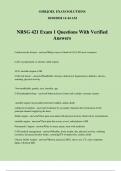©SIRJOEL EXAM SOLUTIONS
10/10/2024 11:44 AM
NRSG 421 Exam 1 Questions With Verified
Answers
Cardiovascular disease - answer✔Major cause of death in US (CAD most common)
CAD: asymptomatic or chronic stable angina
ACS: unstable angina or MI
CAD risk factors - answer✔Modifiable: increase cholesterol, hypertension, diabetes, obesity,
smoking, physical activity
Non-modifiable: gender, race, heredity, age
CAD pathophysiology - answer✔Atherosclerosis forms and occludes coronary arteries
unstable angina>myocardial infarction>sudden cardiac death
collateral circulation - answer✔circulation by secondary channels after obstruction of the
principal channel supplying the heart
Stable angina - answer✔Chest pain associated with physical activity. Relieved by rest/medicine.
unstable angina - answer✔Chest pain that occurs at rest, initial phase of MI
Prinzmetal's Angina - answer✔Due to artery spasm, treat with medicine
CAD medical management - answer✔Healthy, body weight, diet, physical activity, smoking
cessation, decreased alcohol intake, screening/TX of depression, cardiac rehab
Chronic Stable Angina - answer✔History, physical, EKG, stress, test, CT, echo, troponins,
lipids, CK Dash MD
, ©SIRJOEL EXAM SOLUTIONS
10/10/2024 11:44 AM
Duration: few minutes, subsides when activity is stopped, sublingual nitro
EKG: ST depression (heart, trying to repolarize)
Chronic stable angina medication - answer✔aspirin(short acting, dilates artery/vessels)
sublingual nitro(one tab or 1-2 sprays, relief in five minutes duration 30 to 40 minutes, repeat
every 5 minutesX 3 doses)
Long acting nitrates: decreased frequency of angina, and treat Prinzmetal's angina (headache,
hypertension)
ACE and a RBS: control, blood pressure, vasodilation, decrease blood volume, prevent
ventricular remodeling
B - adrenergic, blockers: decrease myocardial contractility (bradycardia, hypotension, wheezing,
wt gain)
Calcium channel blockers: systematic, vasodilation, decreased, myocardial, contractility,
vasodilation, decreased HR (fatigue, headache, edema)
Lipid, lowering drugs: statins
Acute Coronary Syndrome - answer✔Prolonged ischemia, not reversible
Includes: non-ST elevation (NSTEMI), unstable, angina, ST, depressed due to ischemia, ST
(STEMI) (MI, ST elevated, occlusion, potentially reversible)
T wave inversion - answer✔Flipped T waves, meaning, ischemia, repolarization, not occurring
, ©SIRJOEL EXAM SOLUTIONS
10/10/2024 11:44 AM
acute coronary syndrome pathophysiology - answer✔Deterioration of plaque, leads to rupture,
aggregation and thrombus
Result: partial occlusion = UA, or NTEMI, total occlusion = STEMI
Unstable angina - answer✔Chest pain: new onset occurs at rest, or increase in
frequency/duration, pain lasting >10 min
STEMI &.NSTEMI - answer✔STEMI: Emergency, artery opened in 90min with PCI or
thrombolytic
NSTEMI: PCI in 12-72 hours
Acute coronary syndrome manifestations - answer✔Severe chest pain with no relief, heaviness,
pressure, tight, burning locations (neck, jaw, arms, back)
often early in the morning, greater than 20 min
release of catecholamines: diaphoresis, increased, HR/BP, vasoconstriction, skin rash,
cool/clammy, increased HR/BP, then decrease BP, decreased renal perfusion, crackles, JVD,
hepatic engorgement, edema, abnormal sound, N/v, fever
dyshrythmia - answer✔Most common caused by ischemia, electrolyte imbalances, SNS
stimulation, the VT/VF most common cause of prehospital death, left sided/right sided HF,
cardiogenic shock
Acute Coronary Syndrome Diagnostic studies - answer✔Health, history, EKG (changes in QRS,
ST, T-wave), cardiac biomarkers (released after MI) troponins( increase 4-6 hours after, peek at
10-24 hours return to baseline over 10-14 days
others: CK - NB, myoglobin, BNP (stretching)
PQRST - answer✔P: precipitating factors
Q: quality of pain
R: region




